
One of a Kind DDI Design Accommodates a Complex Urban Setting
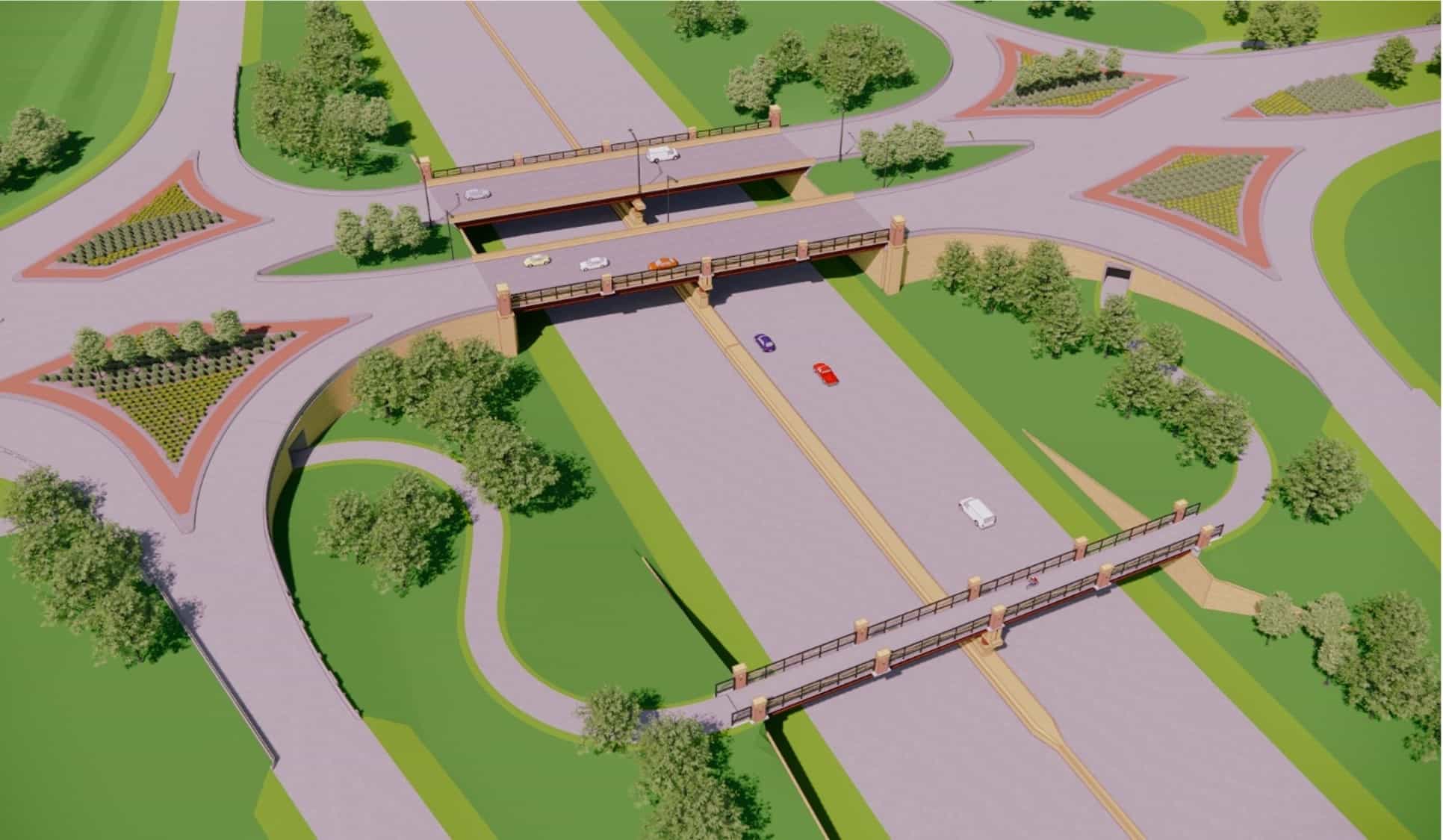
The major interchange along Interstate 80 at Exit 242 (1st Avenue) in Coralville, Iowa was identified for capacity expansion given the surrounding community growth, land use investments, and several safety challenges. The region is growing at an accelerated rate in Coralville, and nearby Iowa City, North Liberty, and Tiffin. 1st Avenue is the major roadway leading from the I-80 interchange to the University of Iowa and the newly minted Iowa River Landing (IRL), a 180- acre mixed-use entertainment, business, retail, conference center, and residential development featuring a University of Iowa Healthcare facility, Xtream Arena multi-purpose facility and Coralville’s multi-modal transportation center that is designed to support convenient, sustainable and accessible community transportation options. The IRL is located in the southeast quadrant of the interchange with access points in close proximity to the interchange.
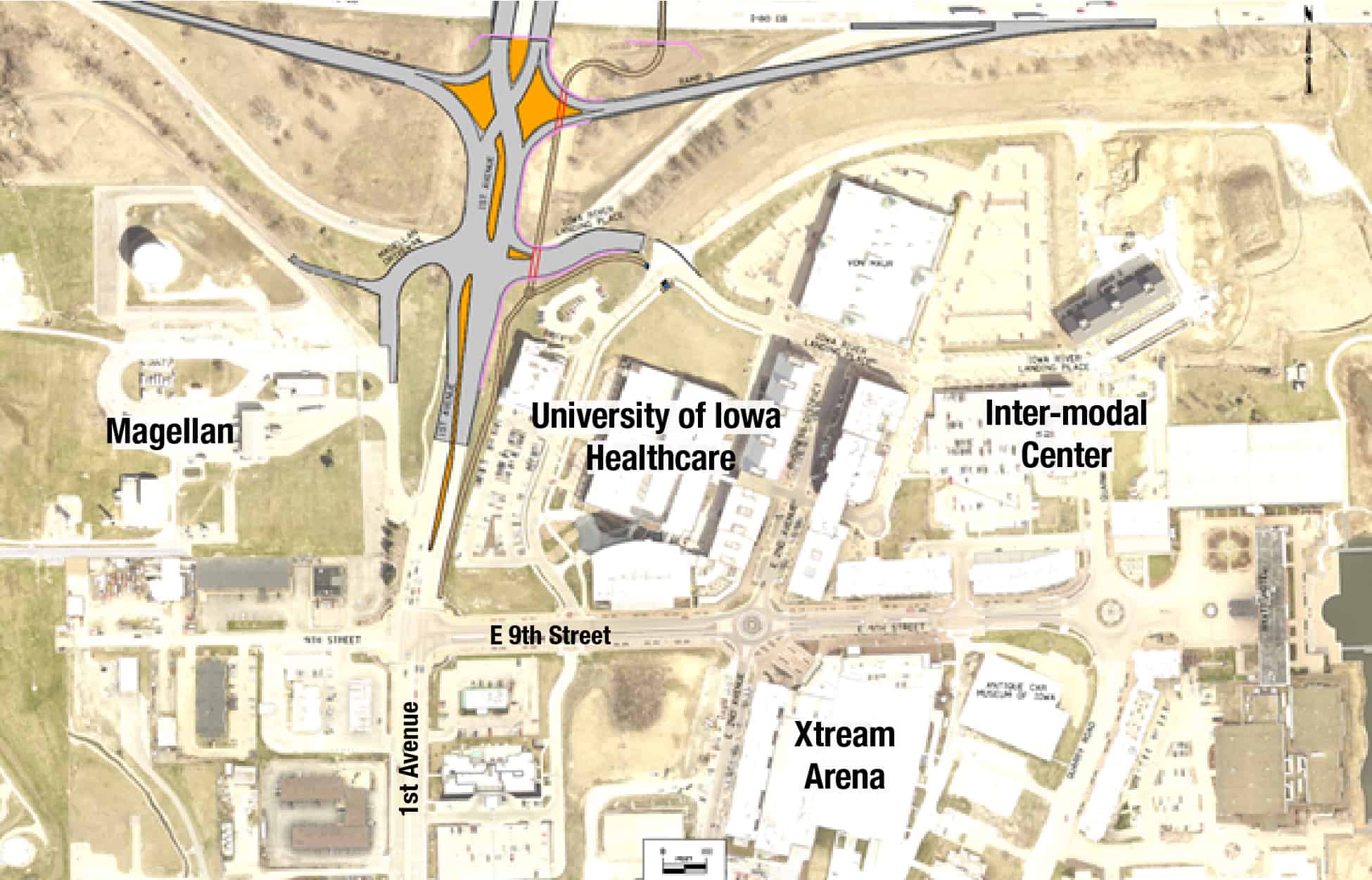
The 1st Avenue corridor south of the interchange is constrained by commercial and retail development and has been enhanced over the last decade to improve capacity and safety. However, the segment immediately adjacent to and through the interchange remains a bottleneck in accommodating the general growth in the region and specifically the growth in popularity of the IRL amenities. Magellan Midstream Partners, LP (Magellan), a gas utility company southwest of the interchange, impacts the corridor operations with high truck traffic volumes and compromises safety at an uncontrolled access point immediately adjacent to the interchange. Trucks often block 1st Avenue traffic to help other trucks gain access to 1st Avenue and the interchange. On the northwest side of the interchange, hotel and residential living complexes add users that often have a desire to travel to the opposite side of the interchange, crossing heavy vehicular traffic. Finally, the northeast quadrant features an existing quarry and pioneer grave area that placed restrictions on expanding the right-of-way (ROW).
The City of Coralville envisioned an opportunity to provide a gateway from I-80 into Coralville while addressing the operational and safety needs for the project. The interchange needs to provide efficient near and long-term Interstate operations and provide safe access to and from the Interstate system while being integrated with the multi-modal aspects of the IRL. Other objectives included improving regional travel reliability, integration of an established active transportation community, and accommodating continued economic development and expansion of multi-modal options associated with the IRL growth.
HR Green has a long history working in the interchange area with their involvement in the transformation of the once-blighted Old Industrial Park into the new IRL complex. Prior to the design, a traffic impact study examined the individual land uses and evaluated existing traffic, projected traffic, projected land uses, peak hour traffic, roadway performance, and roadway capacity requirements for area transportation system users and future conditions. The results of the traffic impact study led to additional studies to identify alternatives for adding capacity to the I-80/1st Avenue interchange.
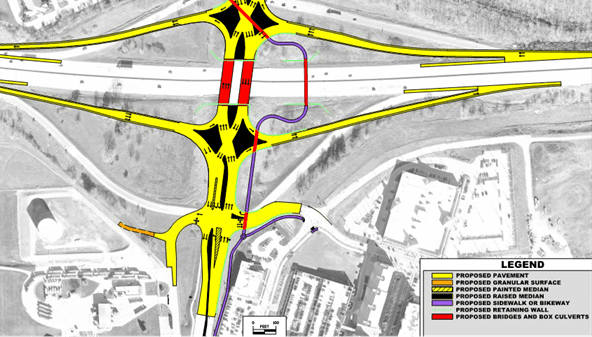
Through the Interchange Justification Report (IJR) process in 2010, a Diverging Diamond Interchange (DDI) alternative was selected over the Partial Cloverleaf (Parclo), Regular Diamond, and Single-Point Interchange. It was determined that the DDI would improve safety by decreasing vehicle conflict points, improve efficiency by increasing capacity, minimize ROW impacts, provide greater pedestrian mobility safety, reduce construction costs, and be the right-sized alternative for future growth and sustainability. Additionally, the alternative provided an additional access point to the IRL and a controlled access point to the Magellan facility within the constrained topography and right-of-way limits.
The design process began in 2018 led by the City of Coralville in partnership with HR Green and the Iowa DOT. A Better Utilizing Investments to Leverage Development (BUILD) grant application was prepared in 2020, and an award of $20.5 million was received in 2021. The final design then began with Iowa DOT as the lead agency. The BUILD grant award combined with Iowa DOT programmed funds will completely cover the $41 million cost of the project.
Not Your Average DDI Interchange
The I-80 Exit 242 interchange design presented many unique challenges that included accommodating a wide range of user needs.
Major Gas Company Anchor Southwest of the DDI Interchange
The Magellan gas company has a long-vested interest in this interchange with major truck traffic needing access to 1st Avenue to the junction with I-80. Entering and exiting this facility presented challenges with truck traffic often occupying both southbound lanes to turn right into the facility and having to negotiate an at-grade trail crossing. Upon leaving the facility, trucks are challenged with entering an increasingly busy 1st Avenue after negotiating the at-grade trail crossing and at times blocking traffic to allow their counterparts access to northbound 1st Avenue to ultimately reach I-80 access.
Once the DDI is constructed, the at-grade trail crossing will be eliminated, and a dedicated traffic signal at the new Magellan driveway, opposite the new Iowa River Landing Place, will be located approximately where the existing ramps tied in.
In addition to the challenges of truck traffic entry and exit into Magellan, the infrastructure includes multiple underground pipelines that cross under 1st Avenue near I-80. Design considerations are needed to consider the risks of disturbing this fixed infrastructure.
Development Anchor Southeast of the Interchange
Continued development of the IRL will result in additional multi-modal needs especially during peak events at the Xtream Arena that will need to move vehicular traffic swiftly off I-80 for safety purposes. Prior to the DDI, traffic backed up during peak events onto I-80 and bottle-necked into the IRL complex at the primary entrance on East 9th Street.
Once the DDI is constructed, the new Iowa River Landing Place access point to the IRL, combined with intelligent signalization, will move peak traffic loads through traffic lights in alignment with traffic flow demands, thereby minimizing traffic congestion.
Trail Safety and Multi-modal Safety
The current trail system in the area is designed at grade on the west side of 1st Avenue and conflicts with motorized traffic jeopardizing pedestrian safety. The City of Coralville takes great pride in its trail system and desire to connect the trail system to the IRL complex. The northwest anchor to the interchange represents pedestrian traffic that will have access needs to IRL.
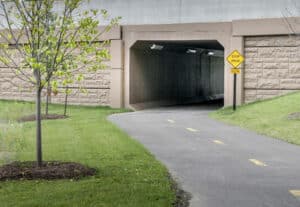
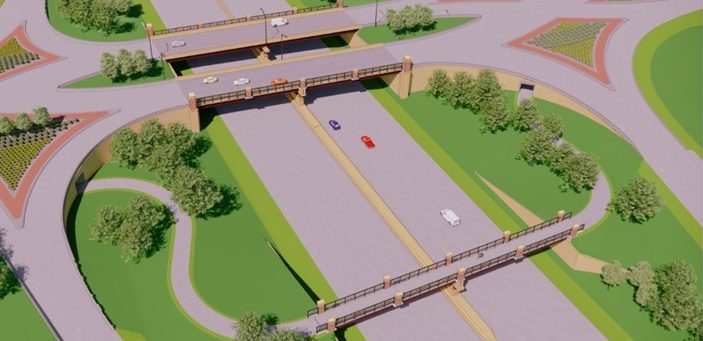
HR Green developed multiple trail alignments ranging from at-grade to a combination of a pedestrian bridge and box culvert alternatives. The twelve trail alternatives were vetted and evaluated based on design constraints, engineering, professional judgment, and discussions with the City and Iowa DOT. An evaluation matrix was developed to help drive the selected alternative by establishing criterion and importance weight factoring. The criterion included trail grade, length / out-of-distance travel, roadway at-grade crossing, wall area, bridge area, tunnel length, user comfort, ROW, horizontal curve, and cost rating. The criterion performance ratings were evaluated based upon preferred attributes to undesirable attributes.
The initial evaluation of the matrix data filtered seven alternatives as less than desirable and the five remaining alternatives were presented to key stakeholders including personnel from the bicycle coalition, emergency services, and the Iowa DOT. From this meeting, three alternatives were determined less desirable which left the two most suitable alternatives; both had an east pedestrian bridge over I-80 and crossed underneath 1st Avenue through a long box culvert (either under the bridges or diagonal under the north ramp connections). The long box culvert underneath 1st Avenue was chosen as the design alternative as it was a more direct alignment for users.
Water Quality
The project will have Stormwater Best Management Practices (BMP) inclusion to the southwest and east quadrants of the interchange that will be maintained by the City. This solution will relieve some of the load off the City storm sewer, improve water quality and help with the interchange drainage and was made possible by the compact DDI configuration and re-purposing of the existing right-of-way.
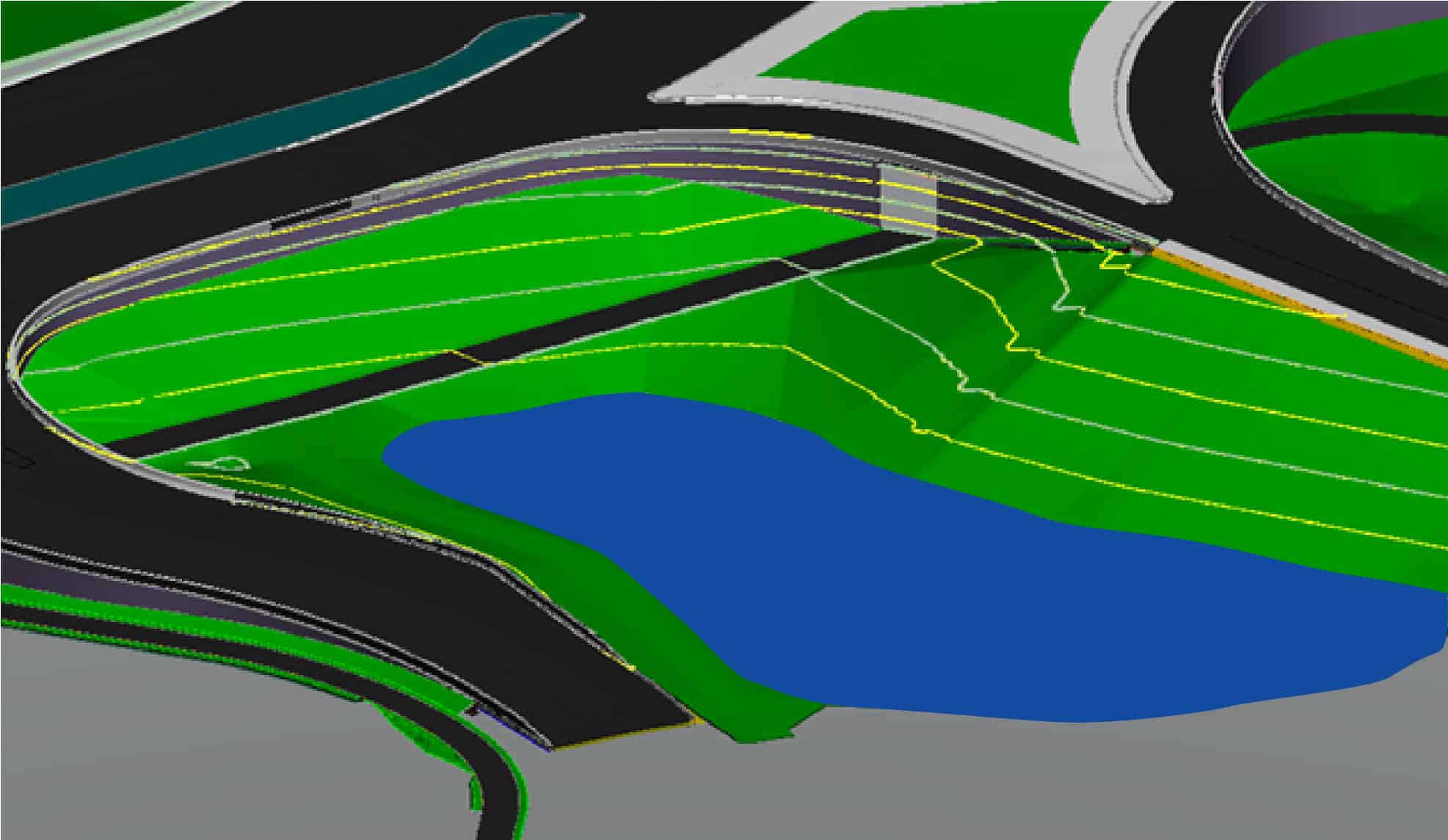
Constructability
Currently, 1st Avenue crosses I-80 as two bridges separated by a two-inch gap. The DDI will be constructed as two separate bridges allowing the construction of one bridge while the existing bridge remains open for use. Not only does two bridge construction help with the overall maintenance of traffic throughout the project construction phase, but it also provides a larger DDI roadway crossing angle for best desirable night traffic regarding oncoming headlights and eliminating the need for reversing curves.
MSE walls near I-80 will replace sloped berms which narrow the footprint of the interchange. This technology helps to raise the interchange for future lane additions and will allow for acceptable spacing from ramps to City roads and entrances, as well as minimizes ROW impacts. The MSE walls also help with the development of the grade-separated trail and the barrier will be used to protect cars and pedestrians.
The Magellan Pipeline has three petroleum pipelines going underneath 1st Avenue in the project area. These pipelines have zero tolerance for settlement from increased fill heights or structures placed over the lines. Several alternatives were explored to mitigate loads from increased fill heights including expanded polystyrene (EPS) foam blocks and lightweight foam concrete. The Iowa DOT, HR Green, and Terracon, the team geotechnical engineer, have concluded the lightweight foam concrete option will be used in constructing the roadway over the pipelines. The lightweight foam concrete alleviates the need for a precast fascia wall and a load distribution slab which would affect construction time.
The construction staging for this significant project will be of paramount importance. Associated General Contractors (AGC) have been brought in to contribute to the construction phasing and constructability review. Pedestrians, as well as traffic, will need to be routed through the construction safely and with the greatest efficiency. The 1st Avenue traffic will be shifted to the existing west bridge in the first stage to build the east bridge. Pedestrians will continue to use their existing route. To build the west bridge pedestrians will be routed to a temporary route and traffic will be shifted to the new east bridge as the west bridge is being built. With the construction of box culverts, MSE walls, and bridges; temporary shoring will be utilized. The project will include an Iowa Communications Network (ICN) fiber which will be installed prior to major wall construction, so it will not interfere with other construction. Throughout each stage, contractor ingress and egress will be evaluated in conjunction with the staging timeline to meet the August 2022 letting. Bridge construction could start in winter 2022-23, and full construction is anticipated to go through 2024, with minor finishing in 2025.
Subscribe to HR Green Insights
We're dedicated to providing up-to-date knowledge and insights about the topics that matter most to you. We know how busy you are, so we will keep this simple, covering just one topic per email. Once you've subscribed, you can easily customize your preferences to receive only the updates relevant to you.
